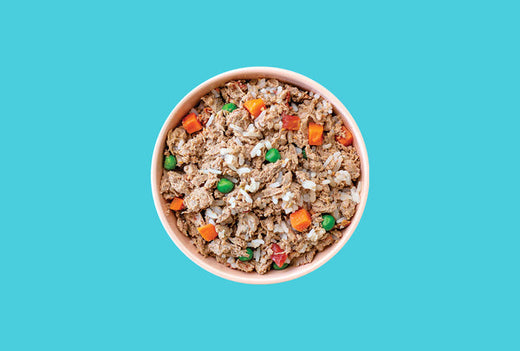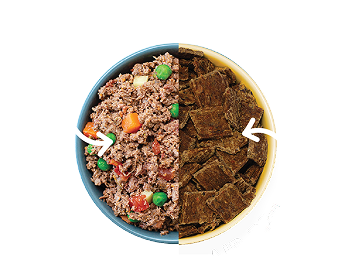
High-Fiber Dog Food: What Are the Benefits?
Table of Contents
- Are There Benefits of High-Fiber Dog Food?
- How Do I Add More Fiber to My Dog's Diet?
- How Much Fiber Does My Dog Need?
- What Are the Pros & Cons of High-Fiber Dog Food?
- Does High Fiber Dog Food Have Side Effects?
- Is High-Fiber Dog Food Good for Diabetes?
- Are High-Fiber Dog Foods Good for Anal Gland Issues?
- Do Senior Dogs Need More Fiber Than Puppies?
- Wrapping Up
Dietary fiber plays a crucial role in maintaining a dog's health by offering benefits that range from improved digestion to weight management. High-fiber dog foods are designed to support your pup's overall well-being by enhancing digestive function and helping regulate weight.
That said, choosing the right high-fiber option requires understanding its benefits, potential drawbacks, and how it fits into your dog's specific needs. In this article, we’ll explore the advantages of high-fiber dog food, how to incorporate it into your dog's diet, and whether it’s the right choice for addressing issues like diabetes or anal gland problems.
Are There Benefits of High-Fiber Dog Food?
High-fiber dog food provides numerous benefits that support your pup’s overall health. One of the primary advantages is improved digestive function. Fiber helps regulate bowel movements, which can soothe symptoms of constipation and diarrhea.
Also, high-fiber diets can aid in weight management. Fiber adds bulk to the diet, which helps your dog feel fuller longer, potentially reducing overeating and aiding in weight control. Simply put, high-fiber foods offer a nutritious option for maintaining your dog's digestive and overall health.
How Do I Add More Fiber to My Dog's Diet?
Adding more fiber to your dog's diet can be straightforward and beneficial. Start by incorporating high-fiber dog foods, such as our Turkey Pilaf dry food, which includes fiber-rich ingredients like sweet potatoes and barley. Alternatively, you can mix fiber-rich vegetables into your dog's meals, such as cooked carrots, peas, berries, or green beans.
For an extra fiber boost, consider adding a small amount of canned pumpkin (plain, not spiced) to their food. Pumpkin is a natural source of fiber and can aid in digestive health.
What’s more, adding a fiber supplement designed specifically for dogs can also be effective. Ensure that any dietary changes are introduced gradually to avoid digestive upset. Regularly monitoring your dog's response to increased fiber and consulting with a veterinarian can help tailor the diet to your dog’s individual needs and maintain optimal health.
How Much Fiber Does My Dog Need?
The amount of fiber a dog needs varies based on their age, size, and health condition. Generally, a diet with 2-5% fiber is considered appropriate for most adult dogs. Puppies and senior dogs may require different levels of fiber depending on their specific health needs.
For dogs with digestive issues or weight management concerns, a higher fiber content may be beneficial. That being said, it is essential not to overdo it because excessive fiber can lead to gastrointestinal upset.
It’s best to consult with a veterinarian to determine the ideal fiber intake for your dog’s individual requirements. Gradually introducing high-fiber foods can help monitor their response and adjust the diet accordingly. Taking a balanced approach to fiber in the diet will support your dog's overall health and digestive well-being.
What Are the Pros & Cons of High-Fiber Dog Food?
Pros
High-fiber dog food offers several benefits, including supporting regular bowel movements. It can also assist in weight management by increasing satiety and mitigating overeating. Also, high-fiber diets can help manage certain health issues by supporting stable blood sugar levels and stool consistency.
Cons
On the downside, high-fiber dog food may lead to gastrointestinal issues, if introduced too quickly or in excessive amounts. It may also result in reduced nutrient absorption if not balanced properly.
Some dogs may not find high-fiber foods as palatable, which could affect their overall intake and enjoyment of meals. As with any dietary change, it is important to consult with a veterinarian to ensure the diet meets your dog’s specific needs.
Does High Fiber Dog Food Have Side Effects?
High-fiber dog food can have side effects if not introduced gradually or if fed in excessive amounts. Common side effects include gastrointestinal issues such as bloating, gas, and diarrhea. Dogs that are not used to a high-fiber diet may experience digestive discomfort as their system adjusts.
Also, an overabundance of fiber can potentially lead to nutrient malabsorption, where essential nutrients may not be adequately absorbed. It's crucial to introduce high-fiber foods slowly and in moderation to allow your dog’s digestive system to adapt.
Is High-Fiber Dog Food Good for Diabetes?
High-fiber dog food can be beneficial for dogs with diabetes. Fiber helps support stable blood sugar levels by slowing the absorption of glucose. This can be particularly helpful in managing diabetes and calming insulin fluctuations.
High-fiber diets can also help with weight management which is often a concern for diabetic dogs. By providing a steady release of energy and promoting a feeling of fullness, high-fiber foods can assist in controlling your dog's weight and overall health. Consulting with a veterinarian is essential to tailor the diet to meet the specific needs of diabetic dogs.
Are High-Fiber Dog Foods Good for Anal Gland Issues?
Another unexpected benefit of high-fiber food is that it can be useful for dogs experiencing anal gland issues. Fiber helps to bulk up the stool, which can aid in expressing the anal glands naturally during bowel movements. This can be particularly useful for dogs with a tendency to develop anal gland problems because the added bulk helps to stimulate the glands and prevent impaction.
By supporting regular stool consistency and bowel movements, high-fiber diets can reduce the likelihood of anal gland issues and discomfort. That said, it is essential to choose a high-fiber food that provides balanced nutrition and to consult with a veterinarian to ensure the diet addresses the specific needs of your dog.
Do Senior Dogs Need More Fiber Than Puppies?
Senior dogs often benefit from higher fiber content in their diet compared to puppies. As dogs age, their digestive system may slow down, and fiber can help maintain regular bowel movements and prevent constipation. Increased fiber also supports weight management, which is crucial for older dogs who may be less active and prone to weight gain.
Another vitally important benefit of fiber for older dogs is that it can help soothe the symptoms of chronic conditions that are more common in senior dogs, such as diabetes or kidney disease, by supporting stable blood sugar levels and promoting overall digestive health.
In contrast, puppies generally require a diet that supports growth and development, with balanced levels of fiber to aid in digestion without interfering with nutrient absorption. Their higher energy needs and rapid growth mean they usually do not require as much fiber as senior dogs.
Wrapping Up
High-fiber dog food offers numerous benefits, from supporting digestive health to aiding in weight management and anal gland issues. While introducing more fiber into your dog’s diet can enhance their overall well-being, it’s essential to balance fiber content with other nutritional needs and adjust gradually to avoid potential side effects.
Senior dogs may benefit from higher fiber intake, whereas puppies require a different balance of nutrients in their diet. For a high-quality, nutritious option, consider the human-grade dog food from A Pup Above, which combines high fiber with other essential nutrients for a well-rounded diet.
Above all else, always consult with a veterinarian to tailor dietary choices to your dog’s specific needs.
Sources:
Obesity in Dogs: A Major Health Threat Hiding in Plain Sight | American Kennel Club
Diabetes in pets | American Veterinary Medical Association
Anal Glands in Dogs: Everything You Need to Know | American Kennel Club
Top Stories

Why Do Dogs Lick Their Paws?

Why Do Dogs Whimper & Make Noises in Their Sleep?

Healthy Vet-Approved Homemade Dog Food Recipes

How To Cook Sweet Potatoes for Dogs






















